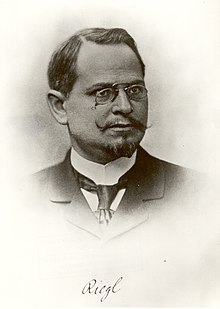

Stilfragen: Grundlegungen zu einer Geschichte der Ornamentik is a book on the history of ornament by the Austrian art historian Alois Riegl. It was published in Berlin in 1893. The English translation renders the title as Problems of style: foundations for a history of ornament, although this has been criticized by some.[a] It has been called "the one great book ever written about the history of ornament."[1]
Riegl wrote the Stilfragen while employed as director of the textile department at what was then the Österreichisches Museum für Kunst und Industrie (today the Museum für angewandte Kunst) in Vienna. His primary intention was to argue that it was possible to write a continuous history of ornament. This position is argued in explicit opposition to that of the "technical-materialist" school, according to which "all art forms were always the direct products of materials and techniques"[2] and that ornamental "motifs originated spontaneously throughout the world at a number of different locations."[3] Riegl associates this view with the followers of Gottfried Semper, who had advanced a related argument in his Der Stil in den technischen Künsten; oder praktischer Ästhetik (Style in the technical arts; or practical aesthetics, 1878–79). However, Riegl consistently disassociates Semper's followers from Semper himself, writing that
The theory of the technical, materialist origin of the earliest ornaments is usually attributed to Gottfried Semper. This association is, however, no more justified than the one made between contemporary Darwinism and Darwin.[4]
As the technical-materialist position had attained the status of dogma, Riegl stated that "the most pressing problem that confronts historians of the decorative arts today is to reintegrate the historical thread that has been severed into a thousand pieces."[5] Accordingly, he argued for a continuous development of ornament from ancient Egyptian through Greek and Roman and up to early Islamic and, eventually, Ottoman art.
Cite error: There are <ref group=lower-alpha> tags or {{efn}} templates on this page, but the references will not show without a {{reflist|group=lower-alpha}} template or {{notelist}} template (see the help page).